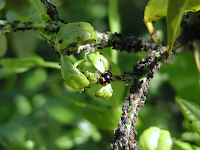 |
| Red scale damage |
 |
| Cottony cussion scale |
 |
| Ladybug and aphid |
Pests, diseases and disorders can affect the external and
internal quality of the fruit as well as the overall yield of the crop.
Correct identification of the source of damage is very important for choosing the best management practice. It is also important to use preventative practices to identify potential sources of damage early, as once the damage is noticed it is often too late to stop the problem.
The following provides information on the identity, monitoring and effective management practices of pests, diseases and disorders of citrus in Western Australia.
Pests of citrus
· Aphids are not usually a problem in citrus, except on young trees.
· Monitoring Young trees from February to March and then again September to December.
· Always check the label before spraying, as not all oils are registered for use in citrus. Oils can also cause phytotoxic damage if not used correctly, such as when plants are heat or water stressed.
· Predators, parasites, and fungal diseases all attack aphids and occur naturally in the orchard. The honeydew produced by the aphids provides a good food source for many natural enemies, as well as pests such as ants.
· The larvae are the damaging stage, attacking the young growth flush and causing leaves to twist and curl.
· This damage is easily identified by the mines that the larvae produce in the leaves. Older trees can usually sustain damage, but young trees can be severely affected.
cultural control
· Insecticidal control is difficult because the larvae are shielded within their mines. The pupal stage is also protected by the rolled leaf margin.
· Horticultural oil sprays reduce numbers by reducing egg lay. The tiny moths avoid surfaces sprayed with oil, so sprays should be applied before too many eggs have been laid.
· Two or more sprays may be required when new leaves are produced over an extended period.
· New growth should be protected as soon as it has formed. Once leaves have hardened, they are resistant to leafminer attack.
· There are several ways to reduce infestations by limiting production of new leaves when leafminer numbers are highest:
· Prune growth flushes.
· Fertilise in late winter to promote strong spring growth when the leafminer is rarer.
· Do not overwater or overfertilise in late summer and autumn.
Biological control
· Three of the most effective parasites in Asia (Citrostichus phyllocnistoides, Cirrospilus quadristriatus and Ageniaspis citricola) were introduced into Queensland in the 1990s. These were then released into Western Australia from Queensland. Only one, Cirrospilus quadristriatus, appears to have established in southern WA.
· A native wasp, Semielacher petiolatus, is also found in WA. Both species attack the larva, leaving distinct pupal cases.
· Parasitism levels are low – usually less than 5% of all larvae appear to be attacked in WA. In Queensland the introduced wasps can parasitise up to 90% of citrus leafminer larvae.
Predators
Generalist predators feed on citrus leafminer. These include green and brown lacewings.
Scale in citrus
Mediterranean fruit fly
Fruit fly in Western Australia
Keep up the fight against fruit fly
Mediterranean fruit fly expert to help local industry
Multi-pronged approach needed to beat fruit fly
Sterile fruit fly trial provides valuable insights for future control
Control of pest snails and slugs
Green coffee scale (
Six-spotted mite
Argentine ants
Big-headed ants, coastal brown ants


No comments:
Post a Comment